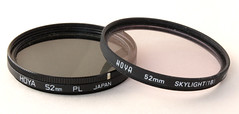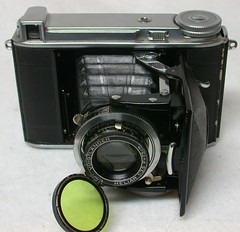Filter

|
| Polarising and Skylight filters for 52mm filter thread fitting image by AWCam (Image rights) |
A filter is an optical device that can be added to the lens of a camera. It consists of one or two glass (or, more recently, plastic or gelatine) plates, mounted in a frame that is fitted to the lens of a camera. Attachment may be push-fit, bayonet, or threaded. Also a filter may be built in to the camera or lens.
Colour filters reduce ("filter") light of a particular colour. Early colour filters were cuvettes which could be filled with coloured water. Nowadays color filters consist of only one glass plate which is coated with a transparent glass color.

|
| Voigtländer Bessa with hinged yellow filter image by Mark O'Brien (Image rights) |
In black and white photography colour filters can be used to improve contrast.
Filters can be grouped as: contrast enhancement, colour correction, neutral, and special effect.
Adding a poor quality filter can greatly degrade lens resolution, widely misunderstood is the high cost of optically flat filters with proper coatings necessary to preserve lens resolution.
Contents
Filter types
Contrast enhancement
In black-and-white photography coloured filters can be used to improve modelling of skin tones (green or yellow-green filters), or to darken washed-out skies and show cloud detail (e.g. yellow filter). Many box-type cameras, and some more sophisticated models, had built in yellow or green filters for these purposes. These filters work because black and white film does not have equal sensitivity for all colours.
For colour photography the only contrast enhancing filter is a polarising filter. In bright sunlight, especially when the sun is high, there are many reflections that will reduce contrast and, since reflections are plane polarised, a polarising filter can greatly reduce reflected light and enhance colour contrast as well as darkening blue sky.
Polarising filters come in two types, plane polarising and the misleadingly named "circular" polarising. Light waves have two properties, electro and magnetic. Plane polarising filters polarise both the same, causing problems for any camera with secondary mirrors for light measurement. "Circular" polarising filters, much more difficult to manufacture, polarise electro and magnetic seperately without secondary effects (simple "Polaroid" dark glasses cause very distracting patterns in car windscreens, "circular" polarised glasses do not).
Colour correction
The primary use of colour correction filters is to correct the colour balance of artificial light when taking photographs indoors or under tungsten lighting, such as on a film set or stage lighting. Early studio lighting was also tungsten and is still preferred by some photographers for its soft tones.
Blue filters are used to correct daylight colour film for tungsten lighting.
Neutral
Special effect
Special types of filters include skylight - which blocks Ultra-Violet (and so improves colour rendering), and polarising, which lets through only light vibrating in a particular plane and can be used to block glare. Effects - such as soft-focus and "sparkling" highlights - can also be produced using special types of filter.
Neutral Density filters (ND filters) merely reduce the level of light, without changing the colour.